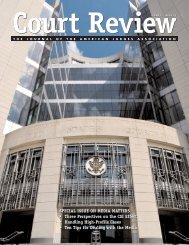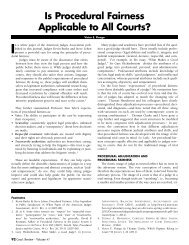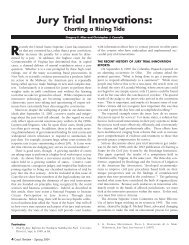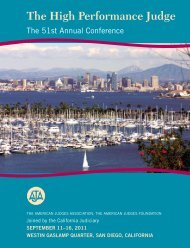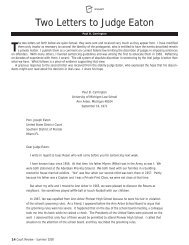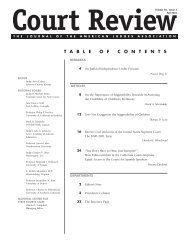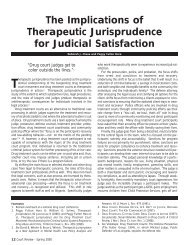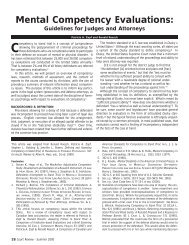Special Issue on Procedural Fairness - American Judges Association
Special Issue on Procedural Fairness - American Judges Association
Special Issue on Procedural Fairness - American Judges Association
- No tags were found...
You also want an ePaper? Increase the reach of your titles
YUMPU automatically turns print PDFs into web optimized ePapers that Google loves.
Commissi<strong>on</strong> <strong>on</strong> Children in Foster Care made a number of recommendati<strong>on</strong>sto C<strong>on</strong>gress to strengthen the Court’s effectivenessin child welfare cases, including that, “Courts should beorganized to enable children and parents to participate in ameaningful way in their own court proceedings.” 8 Advocateshave begun providing practical advice for including children inproceedings including specific suggesti<strong>on</strong>s to prepare childrenfor their court involvement, to make the courtroom processmore comfortable for children, and to assist attorneys andjudges in their ability to ask age-appropriate questi<strong>on</strong>s. 9A recent review of state statutes shows that children have aright to be present at abuse/neglect proceedings in 18 out of 51states (including the District of Columbia), they are c<strong>on</strong>sidereda party in 38 out of 51 states, and they are required to be givennotice in 14 out of 51 states (with age requirements in mostwith this requirement). 10 Additi<strong>on</strong>ally, recent federal legislati<strong>on</strong>sets forth a requirement that “the court or administrativebody c<strong>on</strong>ducting the hearing c<strong>on</strong>sults, in an age-appropriatemanner, with the child regarding the proposed permanency ortransiti<strong>on</strong> plan for the child.” 11Al<strong>on</strong>g with the growing impetus for children’s increasedparticipati<strong>on</strong> has been a growth in efforts to increase children’sknowledge of the judicial process and their rights in the legalsystem. Many states have developed guidebooks or othermaterials to inform about and prepare them for a court experience.12 A number of jurisdicti<strong>on</strong>s provide child victim-witnesspreparati<strong>on</strong> programs. The most formal of these programsinclude educati<strong>on</strong>al interventi<strong>on</strong>s to improve children’sknowledge of courtroom actors and procedures and typicallyinclude pre-trial tours and role-playing exercises. 13 Theseinterventi<strong>on</strong>s are all intended to increase children’s understandingof the legal system so that they can best benefit fromor be most effective in theirparticipati<strong>on</strong>.RESEARCH ON CHILDREN’SPARTICIPATIONGeneral BackgroundAdults who have the opportunityto participate in decisi<strong>on</strong>-makingproceedings andexpress their perspectives perceivethe process and outcomeA few studies haveapplied proceduraljustice theories tochildren or youthand dem<strong>on</strong>stratedthat children andyouth also valuefairness inprocedures.as more fair. 14 The reas<strong>on</strong>s forthe relati<strong>on</strong>ship between participati<strong>on</strong>and fairness judgments are not clear. Someresearchers have argued people value participati<strong>on</strong> in the legalprocess because it provides opportunity to influence the decisi<strong>on</strong>.15 Others argue participati<strong>on</strong> indicates the pers<strong>on</strong>’s valuein the process and this recogniti<strong>on</strong> of individual standing is themain c<strong>on</strong>tributi<strong>on</strong> to the pers<strong>on</strong>’s assessment of fairness. 16A few studies have applied procedural justice theories tochildren or youth and dem<strong>on</strong>strated that children and youthalso value fairness in procedures. The earliest studies exploredprocedural justice as a specific aspect of moral development inchildren. 17 More recently, Hicks and Lawrence assessed adolescents’judgments of procedural justice in hypothetical scenariosinvolving a young thief. 18 They found that, like adults,teens c<strong>on</strong>sider procedural justice factors in assessments ofoverall satisfacti<strong>on</strong> with case outcomes and processes.<strong>Procedural</strong> justice has also been explored within the familyc<strong>on</strong>text. F<strong>on</strong>dacaro and his colleagues asked 240 college studentsto recall a recent family dispute and rate how their parentshandled it al<strong>on</strong>g various dimensi<strong>on</strong>s. 19 Overall judgments8. THE PEW COMMISSION ON CHILDREN IN FOSTER CARE, FOSTERING THEFUTURE: SAFETY, PERMANENCE AND WELL-BEING FOR CHILDREN INFOSTER CARE 18 (May 18, 2004), available at: http://pewfostercare.org/research/docs/FinalReport.pdf.9. See Andrea Khoury, With Me, Not Without Me: How to InvolveChildren in Court, 26 CHILD L. PRAC. 129 (2007).10. Theresa Hughes, State-by-State Summary of a Child’s Right to bePresent/Participate in Child Protective Proceedings (2007),http://www.abanet.org/child/empowerment/involving_youth.html.As of Spring, 2007, children have a right to be present in hearingsin Alabama, Arkansas, California, C<strong>on</strong>necticut, Florida, Illinois,Kansas, Louisiana, Maryland, Minnesota, Missouri, M<strong>on</strong>tana,Ohio, Oreg<strong>on</strong>, Texas, Utah, Virginia, West Virginia.11. Adopti<strong>on</strong> and Safe Families Act, 42 U.S.C. 675(5)(C).12. See, e.g., Phil Ladew, Fight for Your Rights: A Guidebook for CaliforniaFoster Youth, Former Foster Youth and Those Who Care About Them(2007) (The Nati<strong>on</strong>al Center for Youth Law), available at:http://www.youthlaw.org/fileadmin/ncyl/youthlaw/publicati<strong>on</strong>s/fight_for_rights/Fight_for_your_Rights_Handbook_2007.pdf;Nebraska Court Improvement Project, Know Your Rights: A Guidefor Youth in Nebraska’s Foster Care System (2008) (University ofNebraska-Lincoln Center <strong>on</strong> Children, Families and the Law),available at http://www.throughtheeyes.org/ files/Know%20Your%20Rights.pdf; Victims Services Secti<strong>on</strong>, Virginia Department ofCriminal Justice Services, Going to Court: An Activity Book forChildren (2005), available at http://www.dcjs.virginia.gov/victims/documents/goingToCourtColoringBook.pdf.13. See Julie Lipovsky & Paul Stern, Preparing Children for Court: AnInterdisciplinary View, 2 CHILD MALTREATMENT 150 (1997).14. E.g., E. Allan Lind, Ruth Kanfer, & P. Christopher Earley, VoiceC<strong>on</strong>trol, and <strong>Procedural</strong> Justice: Instrumental and N<strong>on</strong>instrumentalC<strong>on</strong>cerns in <strong>Fairness</strong> Judgments, 59 J. PERSONALITY & SOC. PSYCHOL.952 (1990); E. Allan Lind, Tom R. Tyler, & Yuen J. Huo.<strong>Procedural</strong> C<strong>on</strong>text and Culture: Variati<strong>on</strong> in the Antecedents of<strong>Procedural</strong> Justice Judgments, 73 J. PERSONALITY & SOC. PSYCHOL.767 (1997).15. See generally Lind, Kanfer, & Earley, supra note 14; Tina L.Robbins et al., Using the Group-Value Model to Explain the Role ofN<strong>on</strong>instrumental Justice in Distinguishing the Effects of Distributiveand <strong>Procedural</strong> Justice 73 J. OCCUP. & ORG. PSYCHOL. 511 (2000);John Thibaut & Laurens Walker, A Theory of Procedure 66 CAL.L. REV. 54 (1978); Tom R. Tyler & E. Allan Lind, A Relati<strong>on</strong>alModel of Authority in Groups, in 25 ADVANCES IN EXPERIMENTALSOCIAL PSYCHOLOGY 115 (Mark P. Zanna, ed., 1992).16. See, e.g., Tyler & Lind, supra note 15; Tom R. Tyler, PsychologicalModels of the Justice Motive: Antecedents of Distributive and<strong>Procedural</strong> Justices, 67 J. PERSONALITY & SOC. PSYCHOL. 850 (1994).17. See, e.g., Laura J. Gold et al., Children’s Percepti<strong>on</strong>s of <strong>Procedural</strong>Justice 55 CHILD DEV. 1752 (1984).18. Hicks & Lawrence, supra note 2.19. Mark R. F<strong>on</strong>dacaro, Michael E. Dunkle, & Maithilee K. Pathak,<strong>Procedural</strong> Justice in Resolving Family Disputes: A PsychosocialAnalysis of Individual and Family Functi<strong>on</strong>ing in Late Adolescence,27 J. YOUTH & ADOLES. 101 (1998).Court Review - Volume 44 37



